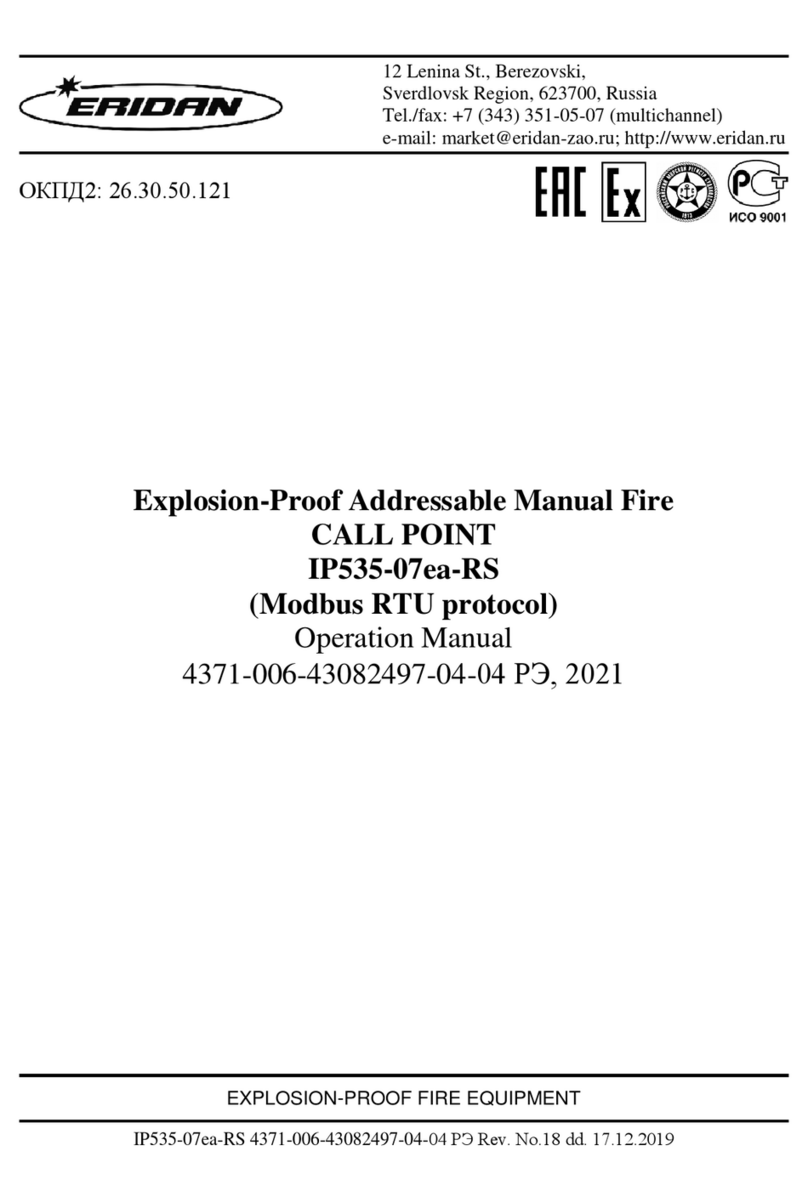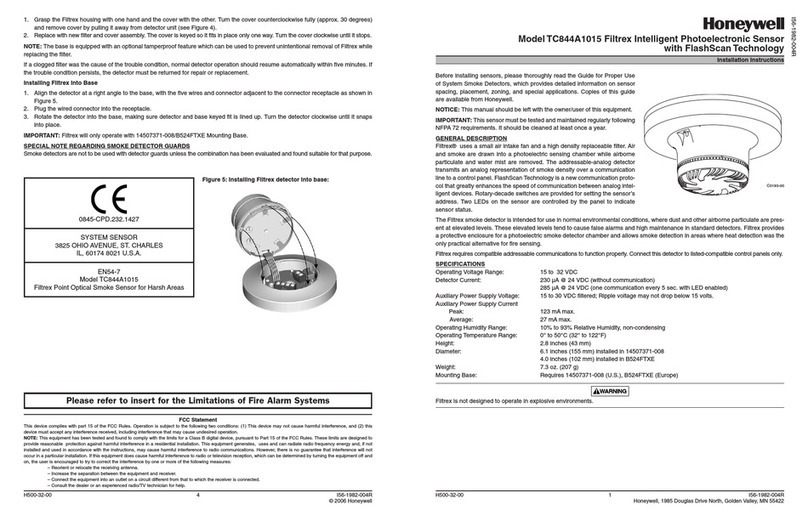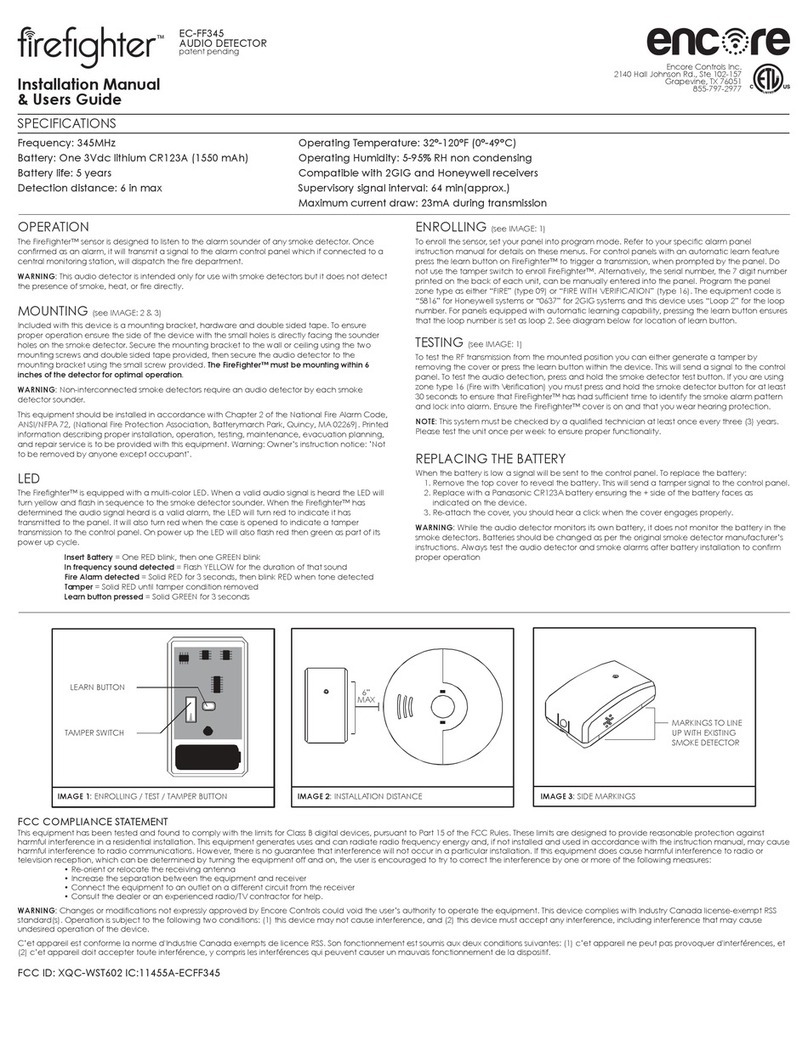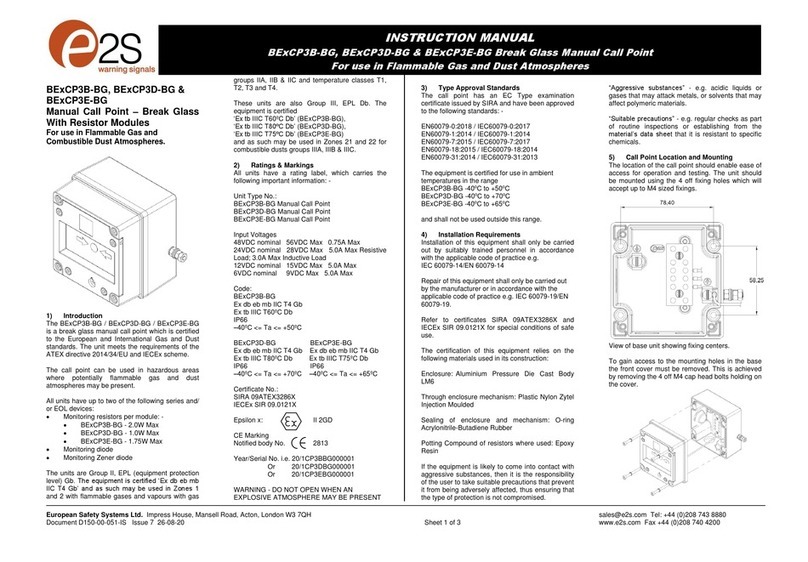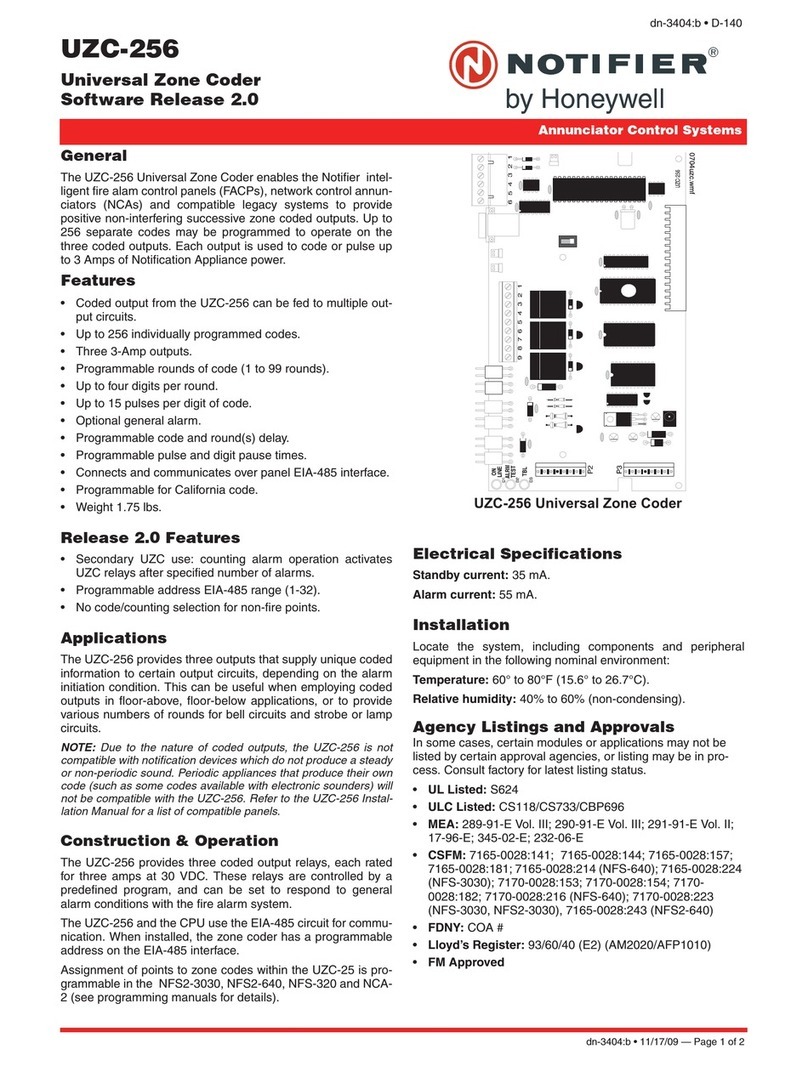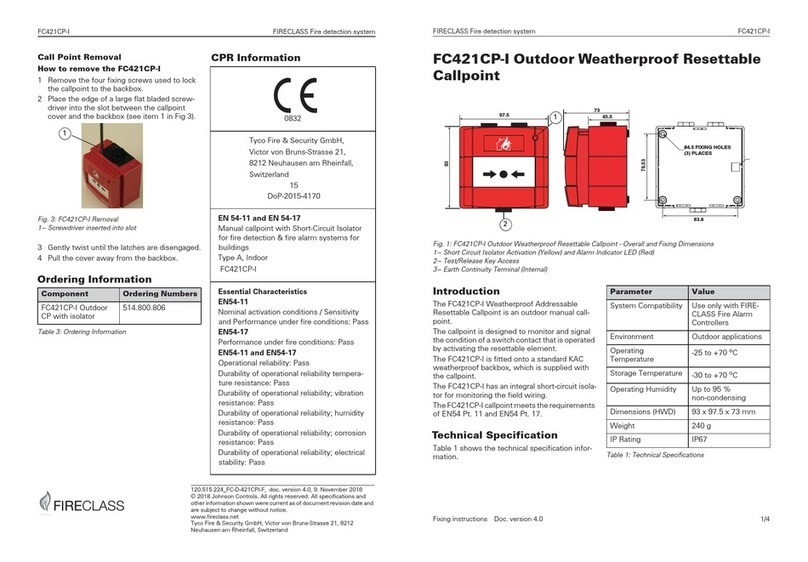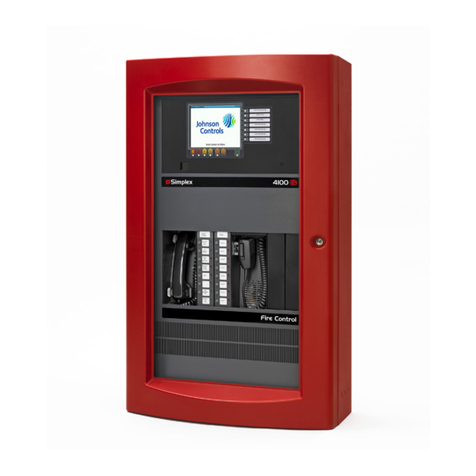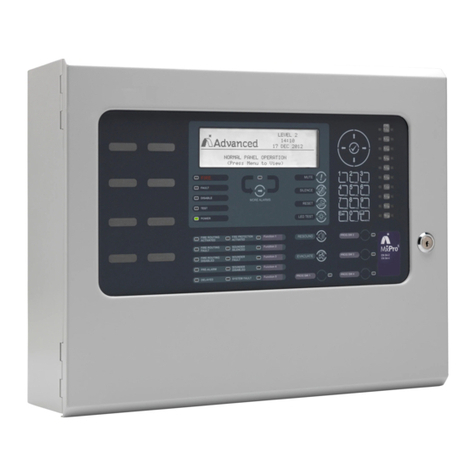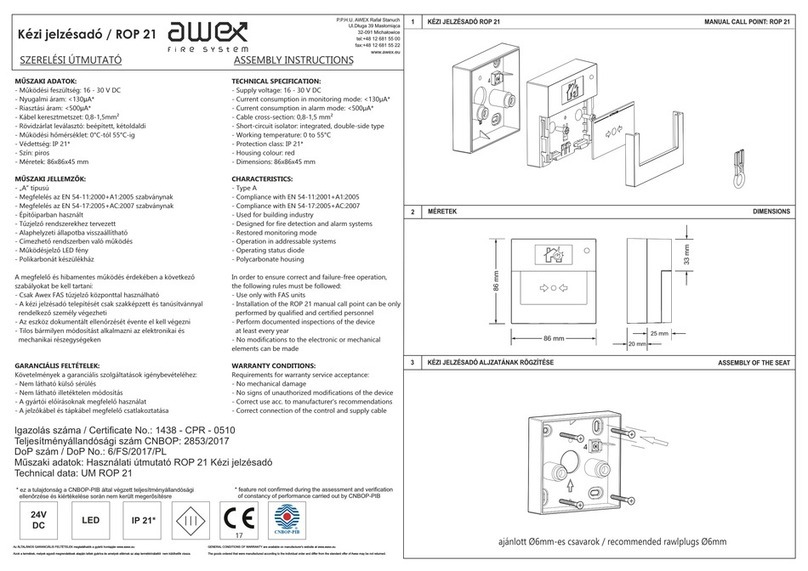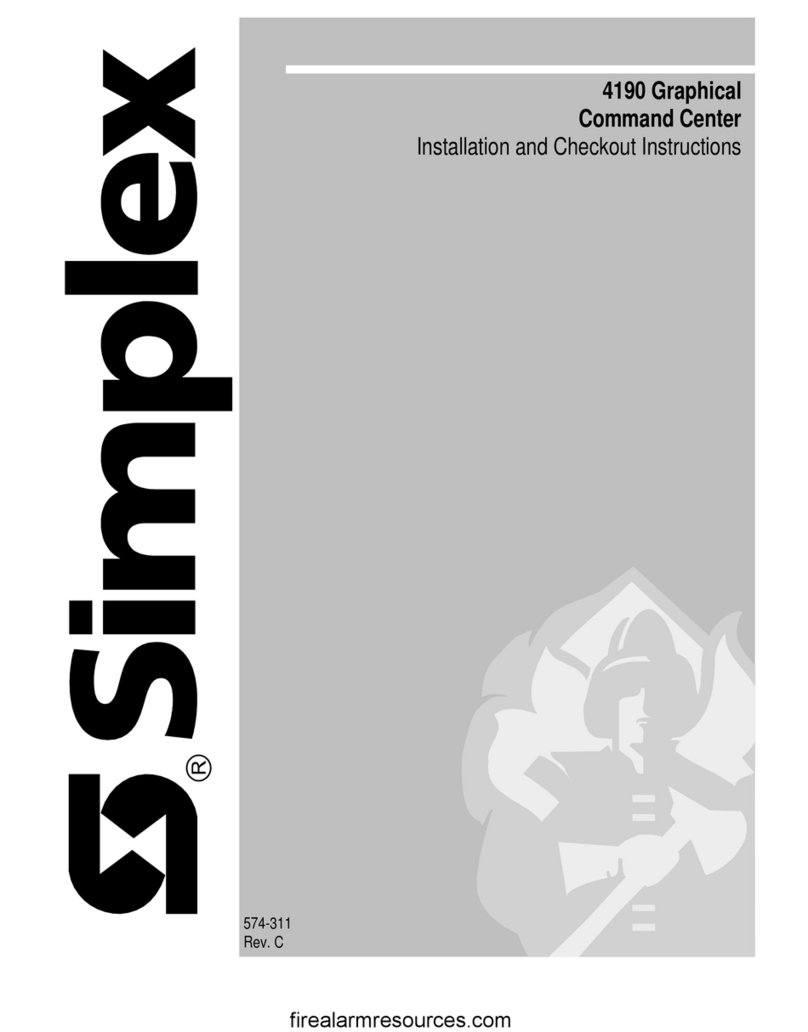Dellcos FM-CO User manual

CARBON MONOXIDE ALARM
With 3 Lamp Display & Single Station
User’s Manual
http://www.dellcos.com
FM-CO FF-CO WD-CO


CONTENTS
CHAPTER 1 INTRODUCTION 4
1. GENERAL SAFETY INFORMATION 4
2. PRODUCT SPECIFICATIONS – (CO series) 6
3. THE DESCRIPTION OF ALARM LIGHT AND SOUNDS 7
CHAPTER 2 INSTALLATION 9
1. WHERE TO INSTALL YOUR CO ALARM 9
2. WHERE NOT TO INSTALL YOUR CO ALARM 9
3. HOW TO INSTALL YOUR CO ALARM 12
4. IMPORTANT ALARM LIGHTS AND SOUNDS 13
5. IF ALARM SOUNDS 14
6. HOW TO MAINTAIN YOUR CO ALARM 15
CHAPTER 3 -
BRIEF DESCRIPTION OF CO ALARM 18
1. WHAT IS CO? 18
2. TROUBLESHOOTING GUIDE 19
3. THE LIMITATION OF CO ALARM 20
4. WARRANTY AND SERVICE 21

4
CHAPTER 1 INTRODUCTION
1. General Safety Information
IMPORTANT!
Danger, Warnings, and Cautions alert you to important
operating instructions or to potentially hazardous
situations. Pay special attention to these items.
IMPORTANT!
This is not a smoke alarm. This CO Alarm is designed to
detect CO from any source of combustion. It is not
designed to detect smoke, fire, or any other gas.
IMPORTANT!
This CO Alarm is approved for use in single-family
residences. It is not designed for marine use.
CAUTION
This CO Alarm will only indicate the presence of CO at
the sensor. CO may be present in other areas.

5
WARNING
Never ignore your CO Alarm if it alarms. Refer to "If your
CO Alarm sounds" for more information. Failure to do so
can result in injury or death.
WARNING
Test the CO Alarm once a week. If the CO Alarm ever
fails to test correctly, have it replaced immediately! If the
CO Alarm is not working properly, it cannot alert you to a
problem.

6
2. Product Specifications
Power Supply Power-cord Type
Electrical Rating 100V~240V.AC 50/60Hz,
14.0mA / 1.4W Max
Operating Temp. 40℉~100℉(4.4℃℃~37.8℃℃)
Relative Humidity 40%~90% RH
Sensor
Electrochemical (Nemoto NAP-505)
Gas Detected Carbon Monoxide
Power Signal Steady Green LED
Alarm Time 70 ppm(Refer P.13)
Alarm Visual Signal Flashing Red LED
Audible Alarm Signal Beep Sound / Min. 85db at 10ft
Alarm Mute Time 3 minutes
Temper Resists Plug Retaining Bracket
Case Color Ivory
Case Dimensions FM-CO : L136 x W101x H42mm
FF-CO : L144 x W84 x H43mm
WD-CO : L132 x W102x H44mm
Warranty 5 Years, Alarm & Sensor
Applicable Standard UL 2034

7
3. The Description of Alarm
Light and Sounds
A. Test/ Reset - For Test and Reset
B. Power light - Green light on (Normal Operation)
C. Malfunction light - Yellow light on
D. Warning light - Red light on
①①Power On
A B C D Horn
on off off Once after 1 min.
A B C D

8
②②Normal operating condition
③③Test/Reset button operation
(When you push the Test/Reset button)
④④Alarm Warning light and sound
⑤⑤Malfunction light and sound
A B C D Horn
on off off Silence
A B C D Horn
on off on Beep’’’
A B C D Horn
on on off Chirp’’’
A B C D Horn
push on
Flickering Flickering
Beep

9
CHAPTER 2 INSTALLATION
1. Where to Install your CO Alarm
Mounting Configuration
CO alarm should be mounted in or near bedrooms and
living areas. It is recommended that you install a CO
alarm on each level of a multi-level home. You may use
the number and location of the smoke alarms installed in
your home according to current building code
requirements as a guide to the location of your CO
alarms.
Location
When choosing your installation locations, make sure you
can hear the alarm from all sleeping areas. If you install only
one Carbon Monoxide alarm in your home, install the alarm
near bedrooms, not in the basement or furnace room.
CAUTION
This Alarm will only indicate the presence of carbon
monoxide at the sensor. Carbon monoxide may be
present in other areas.
IMPORTANT!
Improper location can affect the sensitive electronic
components in this Alarm. Please see the next
section where NOT to install this alarm.
2. Where NOT to Install your CO Alarm
To avoid causing damage to the unit, to provide
optimum protection, and to prevent unnecessary

10
alarms, follow the directions below where NOT to
install this Alarm:
It is not recommended that you install this CO Alarm in
garages or kitchens. Installation in these areas could lead
to nuisance alarms, may expose the sensor to
substances that could damage or contaminate it, or the
alarm may not be heard by persons in other areas of the
home, especially if they are sleeping.
In the kitchen, some gas appliances can emit a short
burst of carbon monoxide upon start-up. This is normal. If
your CO Alarm is mounted too close to these appliances,
it may alarm often and become a nuisance.
If you must install a CO Alarm near a cooking or heating
appliance, install at least 5 feet away from appliance.
Do not install in excessively dusty, dirty or greasy areas
such as kitchens, garages and furnace rooms. Dust grease
or household chemicals can contaminate or coat the
alarm's sensor, causing the alarm not to operate properly.
Do not obstruct the vents located at the top and bottom of
the CO Alarm. Place the CO Alarm where drapes,
furniture or other objects do not block the flow of air to the
vents.
Do not install in dead air spaces, such as peaks of
vaulted ceilings or gabled roofs, where carbon monoxide
may not reach the sensor in time to provide early
warning.
Do not install in turbulent air from ceiling fans. Do not
install near doors and windows that open to the outside,
near fresh air vents, or anywhere that is drafty. Rapid air
circulation from fans or fresh air from outside may cause

11
the sensors to display an inaccurate reading in the
presence of CO.
Do not install CO Alarm in a switch-or dimmer-controlled
outlet.
Do not install in areas where the temperature is colder
than 40℉(4.4℃) or hotter than 100℉(37.8℃). These
areas include unconditioned crawl spaces, attics, porches
and garages. Extreme temperatures will affect the
sensitivity of the alarm.
Do not install CO Alarm near deep cell large batteries.
Large batteries have emission that can cause the CO
Alarm to perform at less than optimum performance.
Avoid the following:
*Excessive spillage or reverse venting of fuel burning
appliances caused by outdoor ambient conditions, such as:
1) Wind direction and/or velocity, including high gusts of
wind. Heavy air in the vent pipes (cold/humid air with
extended periods between cycles).
2) Negative pressure differential resulting from the use of
exhaust fans.
3)Simultaneous operation of several fuel burning
appliances competing for limited internal air.
4) Vent pipe connections vibrating loose from clothes
dryers, furnaces or water heaters.
5) Obstructions in or unconventional vent pipe designs
which can amplify the above situations.
*Extended operation of unvented fuel burning devices
(range, oven, fireplace, etc.).
*Temperature inversions which can trap exhaust gases
near the ground.
*Car idling in an open or closed attached garage, or near a
home.

12
3. How to Install your CO Alarm
WARNING
This CO Alarm is operated by AC without a standby
battery, and will not operate during power failure, and
do not install in a wall switch controlled outlet.
FF-CO
WD-CO
FM-CO

13
Recommended Locations :
1. After selecting the proper gas detector location as
described in Section 1, use a screwdriver to mount the
bracket using the appropriate holes.
2. If you have securely mounted the bracket, you can
install the gas detector.
3. If you have finished detector in stall, just plug into a
standard unswitched 100V~240V AC outlet.
4. Green light will be on. It means the unit is powered on.
The sound will “beep” one time after 1 minutes with
Green light up simultaneously.
5.Press the Test/Reset button until you can hear
following sounds: 3 beeps within one second, then
pause 4 seconds and yellow and red light is flickering-
repeating same pattern. This is normal condition.
4. Important Alarm Lights and Sounds
1. Malfunction warning: Green light and yellow light will
be on, Red light will be off and the sound will chirp one

14
time, 10 seconds pause-repeating same pattern. If
your unit is malfunction, please replace it right away.
2. Alarm Warning Light and Sound: Green light and red
light will be on. Sound is Beeping 4 times for four
seconds followed by 4 seconds of silence, then will
repeat same pattern.
IMPORTANT!
This CO Alarm meets the alarm response time
requirements of UL standard 2034 which are follows:
At 70 ppm, the unit must alarm within 60-240 minutes.
At 150 ppm, the unit must alarm within 10-50 minutes.
At 400 ppm, the unit must alarm within 4-15 minutes.
IMPORTANT!
Noticed or familiarized to your family members above
alarm pattern.
5. If Alarm Sounds
What to do if the Alarm sounds for CO
Activation of the CO Alarm indicates the presence of
carbon monoxide, which can cause an explosion and/or
fire. When the unit senses carbon monoxide, the alarm
will emit a loud alarm pattern. The alarm pattern for CO is
a 4 one-second beep followed by a 4 seconds of silence
then repeating. Know how to respond to a CO
emergency. If the unit alarms for CO:
1) Evacuate the premises.
2) Do not activate any electrical switch or telephone.
3) Contact your fire department.

15
IMPORTANT!
This unit is NOT suitable as a smoke alarm, or to detect
other gases. This device is not suitable for installation in
a hazardous, as defined in the National Electrical Code.
If you call a qualified service technician (such as a
licensed heating contractor, utility service technician or
fuel provider) to inspect your home for possible sources
of CO, tell the technician what might have caused alarm.
Do not restart these appliances until the problem is
corrected. Request service for as soon as possible, like
today.
Please be aware that some service technicians may
charge a fee to inspect your home, even if the source of
CO is not found. You may wish to find out if you will be
charged for the service and the amount of the fee before
you request service. Some public utilities do not charge
for inspection. Some service technicians do not charge if
you purchased your appliance from them. To know for
sure, you need to ask before the technician comes to
your home. Repair work or replacement of appliances
may be necessary to fix the problem that is creating the
CO in your home. Remember, a CO Alarm can only
warn you of the presence of CO, it does not prevent
CO from occurring, nor can it solve an existing CO
problem.
Because you've provided ventilation by leaving your
windows and doors open, the CO buildup may have
dissipated by the time help responds. Although your
problem may appear to be temporarily solved, it's crucial
that the source of the CO is determined and appropriate
repairs are made.

16
6. How to maintain your CO Alarm
To keep your CO Alarm in good working order, you must
follow these simple steps:
What you should do:
Test the CO Alarm once a week by pressing the
Test/Reset button.
Vacuum the CO Alarm cover once a week to remove
accumulated dust. Use the soft brush attachment of
your vacuum cleaner, and unplug the CO Alarm from
the electrical outlet before vacuuming.
Instruct children never to touch, unplug or otherwise
interfere with the CO Alarm.
What you should NOT do:
Never use detergents or solvents to clean the CO
Alarm. Chemicals can permanently damage or
temporarily contaminate the sensor.
Avoid spraying air fresheners, hair spray, paint or other
aerosols near the CO Alarm.
Do not paint the CO Alarm. Paint will seal the vents and
interfere with proper sensor operation.
Do not mount the CO Alarm directly above or near a
diaper pail, as high amounts of methane gas can cause
a CO Alarm.
If you will be staining or stripping wood floors or furniture,
painting, wall-papering, or using aerosols or adhesives for
a do-it-yourself project or hobby, before you begin:
Remove the CO Alarm to a remote location to prevent
possible damage to or contamination of the sensor.

17
You may wish to unplug the CO Alarm and store in a
plastic bag during the project.
The following is a list of substances that at high levels
can affect the sensor and cause an alarm.
Methane, propane, iso-butane, ethylene, ethanol, alcohol,
iso-propanol, benzene, toluene, ethyl acetate, hydrogen,
hydrogen sulfide, sulfur dioxides.
Also most aerosol sprays, alcohol based products, paints,
thinners, solvents, adhesives, hair sprays, aftershaves,
perfumes, auto exhaust (cold start) and some cleaning
agents.

18
CHAPTER 3 BRIEF DESCRIPTION
OF CO ALARM
1. What is Carbon Monoxide?
What is Carbon Monoxide?
Carbon Monoxide (CO) is an odorless, colorless,
poisonous gas created when any fuel is burned -
gasoline, propane, natural gas, oil, wood, coal and even
tobacco. When combustion air is limited, more CO is
produced. Serious problems can develop when
combustion by-products are not properly vented outside
the house.
When you breathe carbon monoxide, it enters your
bloodstream through your lungs and attaches to red
blood cells. These red blood cells, called hemoglobin,
carry oxygen throughout your body. Carbon monoxide
molecules attach to the red blood cells 200 times faster
than oxygen, preventing the flow of oxygen to your heart,
brain and vital organs. As carbon monoxide accumulates
in your blood stream, your body becomes starved for
oxygen. Breathing very high concentrations of carbon
monoxide can be lethal in minutes. Breathing low
concentrations over time is dangerous, too.

19
2. Troubleshooting Guide
If you find problem This means How can solve the
problem
Green light is OFF,
and CO Alarm does
not operate, Press
the Test/Reset
button.
CO Alarm may not
be receiving power. Push the CO Alarm
plug into outlet.
Then, try again to
press Test/Reset
button.
CO Alarm keep on
alarming even
through you press
the Test/Reset
button.
Carbon monoxide
may be existing high
level.
Evacuate from your
home immediately or
follow according to “If
alarm sounds”on
page.
Green light is ON,
Yellow light is on and
1 chirp sound for
every 10 seconds.
CO Alarm is
malfunction. CO
Alarm needs to be
replaced.
Unit under warranty
should be returned to
manufacture for
replacement. See
“warranty and service”
CO Alarm alarms
frequently without
revealing high level
of CO.
The CO Alarm may
be installed wrong
place. Refer to
“Where Not to install
your CO Alarm”

20
3. The limitation of CO Alarm
CO Alarms are not smoke alarms. CO Alarm do not
sense smoke or fire. For early warning of fire you
must install smoke alarms, even though carbon
monoxide can be generated by a fire.
CO Alarms should not be used to detect the
presence of natural gas (methane), propane,
butane or other combustible fuels.
CO Alarms will not operate without power. This CO
alarm requires a continuous supply of electric
power.
CO Alarms can only sense CO that reaches the
unit's sensor. Carbon monoxide may be present in
other areas. The rate at which CO reaches the unit
may be affected by doors or other obstructions.
Also, CO could be present on one level of home
and not reach a CO alarm installed on a different
level. For this reason, we suggest you provide CO
Alarms each room and hallway.
CO Alarms are not a substitute for life, property
damage, or other insurance of any kind.
Appropriate insurance coverage is your
responsibility. Consult your insurance agent.
CO Alarms have a limited operational life. You must
test your CO alarm weekly, because it could fail to
operate any time without notice. If you find the
malfunction of unit, replace it right away.
This manual suits for next models
2
Table of contents
Popular Fire Alarm manuals by other brands
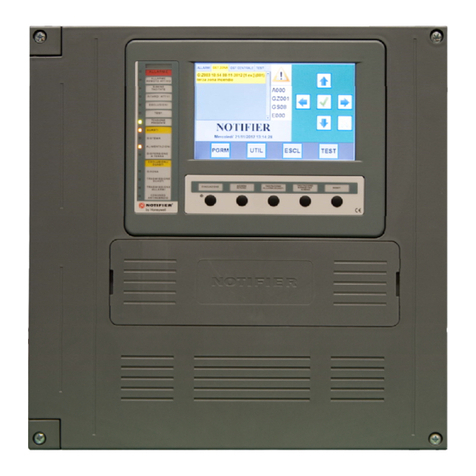
Honeywell
Honeywell NOTIFIER AM-8000 installation manual

GST
GST DC-9204E quick start guide
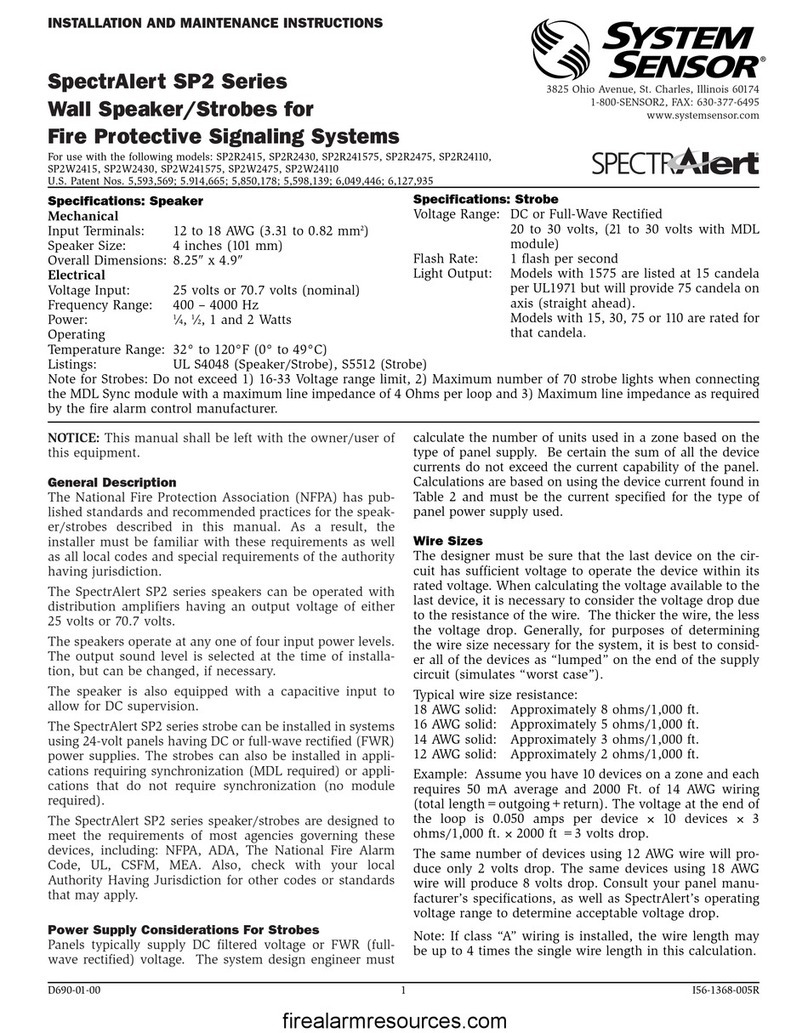
System Sensor
System Sensor SP2R Installation and maintenance instructions
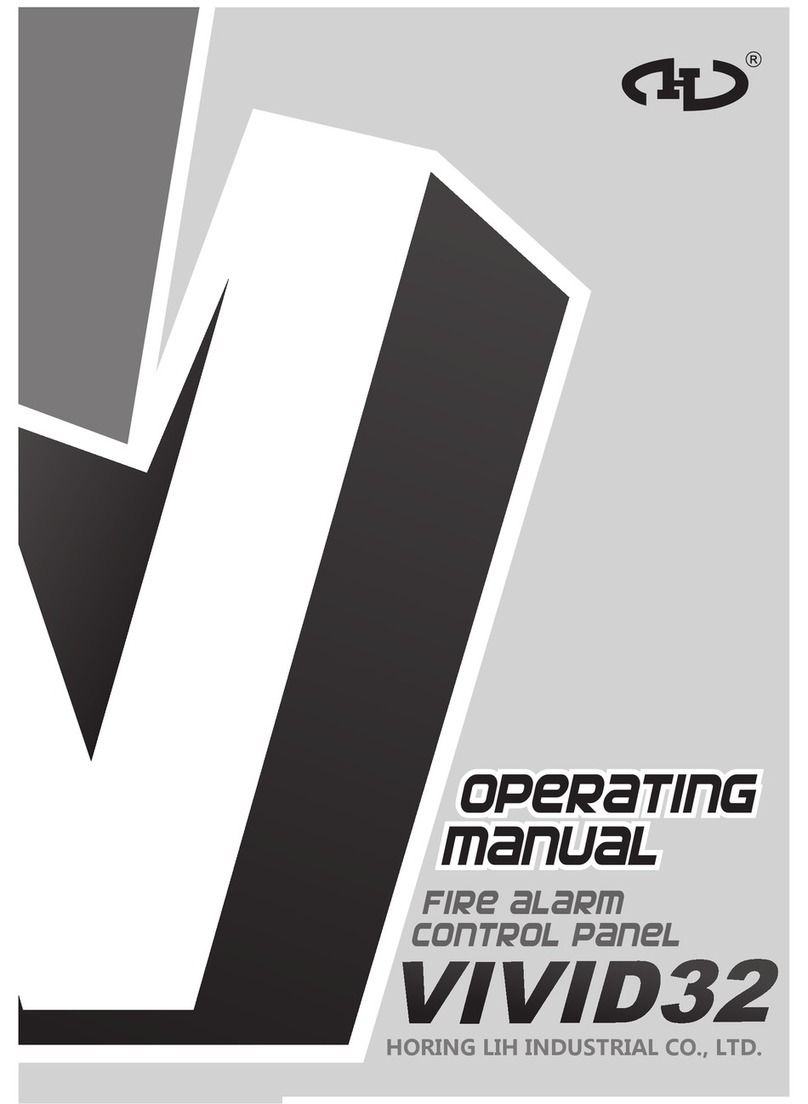
Horing LIH
Horing LIH VIVID32 operating manual
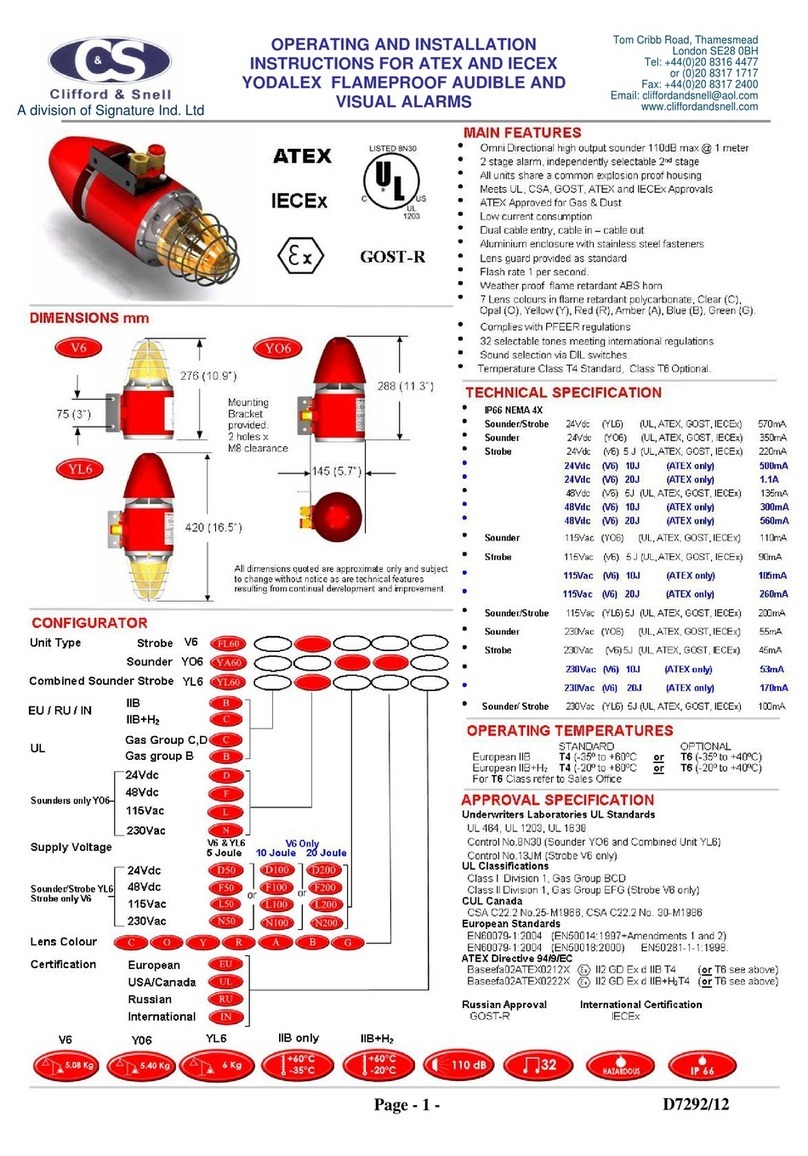
C&S
C&S YA60BD Operating and installation instructions

Simplex
Simplex TFX-500M Operator's manual

